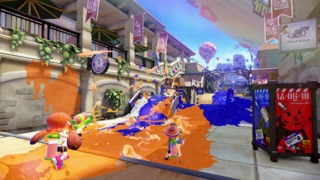Splatoon: Origins and eSports Potential of Nintendo's Non-Violent Wii U Shooter
We talk with producer Hisashi Nogami about Nintendo's upcoming family-friendly shooter.
The competitive gaming scene for shooter games is dominated by Call of Duty and Counter-Strike, but could Nintendo's new family-friendly shooter Splatoon ever join the ranks? It might seem like a stretch. But producer Hisashi Nogami told GameSpot that the non-violent Wii U game where you shoot ink instead of bullets has been designed to support a variety of playstyles--including ultra-competitive.
"The guiding impulse for making Splatoon was not to say, 'Let's make a shooting game for beginners, but a game that people are going to be able to enjoy with a variety of playstyles, variety of skill levels,'" he said when asked if he thought Splatoon would be a good fit for professional competitive gaming. "And so it's not outside the realm of possibility that the game could be enjoyed in that way."
Fallout 4 Next Gen Update Comparison Stellar Blade - (Almost) All Outfits Granblue Fantasy: Relink - New Content Trailer Modern Warfare III - New Season 3 Reloaded Modern Warfare Zombies Update River City Girls 2 - New Playable Characters DLC Reveal!! Sand Land Review Stellar Blade - Hard Mode No Damage Abaddon Boss Gameplay That Time I Got Reincarnated as a Slime ISEKAI Chronicles – Official Announcement Trailer MEGATON MUSASHI W: WIRED – Official OP “MUSASHI English Ver.” Trailer Gothic 1 Remake | Official Collector's Edition Trailer SaGa Emerald Beyond – Official Launch Trailer Paper Mario: The Thousand-Year Door – Official Switch Overview Trailer
Please enter your date of birth to view this video
By clicking 'enter', you agree to GameSpot's
Terms of Use and Privacy Policy
"Personally speaking, I feel like there is sort of a sport element to Splatoon in that you're constantly adjusting to situations on the battlefield; looking, 'Oh this space is open here, let's attack,' or, 'Oh, we need to defend here.' So there's this offense-defense dynamic," he added. "And in that way [it] resembles a sport."
Splatoon, however, is lacking one major feature found in almost every other competitive shooter: voice chat. The game won't support this communication method due to toxicity concerns, co-director Yusuke Amano said previously. Instead, Nintendo suggests that players use the bird's eye view on the Wii U GamePad to determine their strategy.
A family-friendly twist on the classic arena deathmatch formula, Splatoon challenges players not necessarily to shoot opponents directly all the time, but to cover as much of the level in their own team's paint color. For more on how the game works, check out the video below.
We also quizzed Nogami about the origins of Splatoon. He said the idea was born within Nintendo's Entertainment Analysis and Development (EAD) division, which is also behind iconic games like Super Mario 64 and The Legend of Zelda: Ocarina of Time.
"The concept was making a game that wasn't tied into any of our pre-existing franchises and that was going to be its own thing," Nogami said. "And we started by at first getting our team together; and at that point there were a lot of different competing ideas but Splatoon was the one we ended up going with."

From within this starting point, Nintendo designers built a prototype for what would ultimately become the octopus-themed shooter that GameSpot critic Peter Brown contends could be Nintendo's next big thing. The team wasn't dead-set on ink being a central part of the game from the outset, however.
"It was going to start as a competitive, team-based game in which people would shoot ink and be able to hide in that ink, compet[ing] against each other by spreading territory and taking territory," Nogami said. "And that's the next step from that initial concept phase."
"That isn't to say we started by saying, 'OK we're going to make a game in which you spray ink.' More that, in wanting to make a strategic, team-based game, exploring the game logic that arose from that desire, the ink was just sort of the medium that naturally arose from that exploration that they made on the team."
Splatoon arrives May 29 exclusively for Wii U. Nintendo has also teamed up with Best Buy to offer a $300 Splatoon-themed Wii U bundle that comes with a copy of the game.

Got a news tip or want to contact us directly? Email news@gamespot.com










Join the conversation